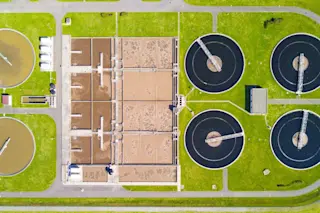Wastewater treatment plant (Credit: Peteri/shutterstock) Antibiotics save us from all kinds of unfortunate ailments, from strep throat to ear infections. But the bacteria that cause these and other ailments are gaining an edge. Antibiotic resistant bacteria are on the rise around the world and spreading in people as well as the environment, making it harder to treat infectious diseases. Antibiotic resistant bacteria grow in places that humans interact with, like our water systems. Urban wastewater treatment plants teem with antibiotic resistant bacteria. Now, researchers find the amount of antibiotic resistant genes in wastewater from seven European countries matches the prevalence of antibiotic resistant bacteria found in patients in those regions. The discovery suggests wastewater treatment plants might act as a breeding ground for antibiotic resistance.
Rampant Resistance
In 2015, the World Health Organization initiated a worldwide action plan to fight antibiotic resistance. Part of the plan is to find out how strong and how widespread antibiotic resistance is. As part of that initiative, the European Center for Disease Prevention tracked the prevalence of antibiotic resistant bacteria present in blood and cerebrospinal fluid samples from patients in 30 countries. The survey revealed gradients of antibiotic resistance across the continent. Resistance became more widespread from north to south and west to east. Urban wastewater treatment plants are one of the best ways antibiotic resistance travels from humans into the environment. In the new study, researchers took samples of wastewater going into and coming out of 12 wastewater treatment plants in seven European countries. They figured out how much bacteria were in the samples and extracted DNA to find out how prevalent antibiotic resistant genes were in the wastewater that entered the treatment plant compared to the wastewater that came out of it.
Mirrored Microbes
The survey revealed antibiotic resistance in the in-coming wastewater mirrored antibiotic resistance gradient in patients, the researchers reported Wednesday in the journal Science Advances. Wastewater going into treatment plants showed more antibiotic resistance in Portugal, Spain, Cyprus and Ireland — countries with higher antibiotic consumption — than in Germany, Finland and Norway. For the most part, the wastewater treatment plants did their job. The researchers found antibiotic resistance was lower in outgoing wastewater in the vast majority of treatment plants, although the trend in abundance across the continent remained. Yet, bacterial genes resistant to an antibiotic known as vancomycin actually became more abundant after water treatment as did genes resistant to sulfonamide antibiotics in a few countries. "In this study, 11 of the 12 wastewater treatment plants under investigation mitigated the resistance problem, which seems to indicate that modern plants work well in this regard," Marko Virta, a microbiologist at the University of Helsinki in Finland, who led the new research, said in a press statement. "At the same time, an older plant or otherwise deficient purification process may end up increasing antibiotic resistance in the environment.”














